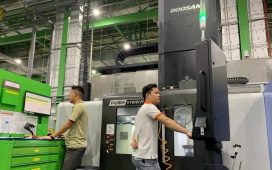Quantum computers could be built within years rather than decades, according to Microsoft, which has unveiled a breakthrough that it said could pave the way for faster development.
The tech firm has developed a chip which, it says, echoes the invention of the semiconductors that made today’s smartphones, computers and electronics possible by miniaturisation and increased processing power.
The chip is powered by the world’s first topoconductor, which can create a new state of matter that is not a solid, liquid, or gas – making it possible to design quantum systems that fit in a single chip smaller than the palm of a hand, and to create more reliable hardware, a peer-reviewed paper published in Nature reports.
Paul Stevenson, a professor of physics at the University of Surrey, said Microsoft could be “very serious competitors” in the race to build the first reliable quantum computers if the company successfully built on this research.
“The new papers are a significant step, but as with much promising work in quantum computing, the next steps are difficult and until the next steps have been achieved, it is too soon to be anything more than cautiously optimistic,” he said.
George Booth, a professor of theoretical physics at King’s College London, said the research represented an “impressive technical achievement”, albeit one whose value would probably become clear only with hindsight. “Whether a claim of ‘years’ [rather than decades before meaningful development] is accurate will remain to be seen,” he said.
Microsoft claims that the topoconductor offers a path to developing quantum systems that can scale to a million qubits – the delicate building blocks of quantum computers that are analogous to the ones and zeros computers currently use.
This could eventually produce the most powerful computers yet, based on quantum mechanics rather than classical physics, which would be capable of solving highly complex industrial and societal problems.
This could include breaking down microplastics into harmless byproducts; inventing self-healing materials for construction, manufacturing or healthcare; solving complex logistics supply chain problems; or cracking encryption codes.
after newsletter promotion
Earlier this month, the US Defense Advanced Research Projects Agency (Darpa) selected Microsoft’s topoconductor as one of two pathways to quantum computing it is exploring as part of a programme intended to determine whether it is possible to build an industrially useful quantum computer by 2033, much faster than most predictions.
The other approach is created by PsiQuantum, which is using silicon-based photonics, meaning light wave-based technology, to create a quantum computer based on a lattice-like fabric of photonic qubits.
Microsoft previously claimed to have developed topological qubits in a paper that had to be retracted after scientific flaws were pointed out.
Booth said that although Microsoft’s progress had been slow relative to some other companies, it had instead “focused on the long game by working on a system which is inherently more resilient to noise and interference” than the fragile basic quantum computers that competitors have been building for a few years.
“These topological qubits protect the information they carry by using the properties of a new type of emergent particle, a Majorana fermion, which means that it is harder for this information to be lost as it is processed. However, [there is an] added layer of complexity when constructing these qubits when compared to competing architectures,” he said.
These Majorana particles had never previously been seen or made. Microsoft said they had to be “coaxed into existence with magnetic fields and superconductors”, which is why most quantum computing research has focused on other approaches.
Booth said the research represented a step in the direction of a very different platform that could “compete with the more mature technologies pioneered by the likes of Google”, though he added that there was still a long way to go in demonstrating that the technology could be scaled up.











